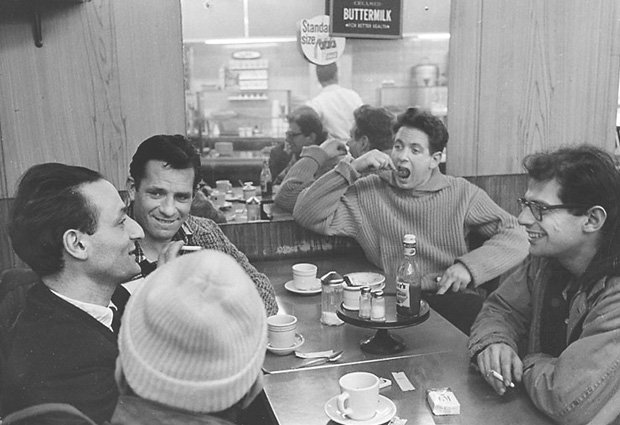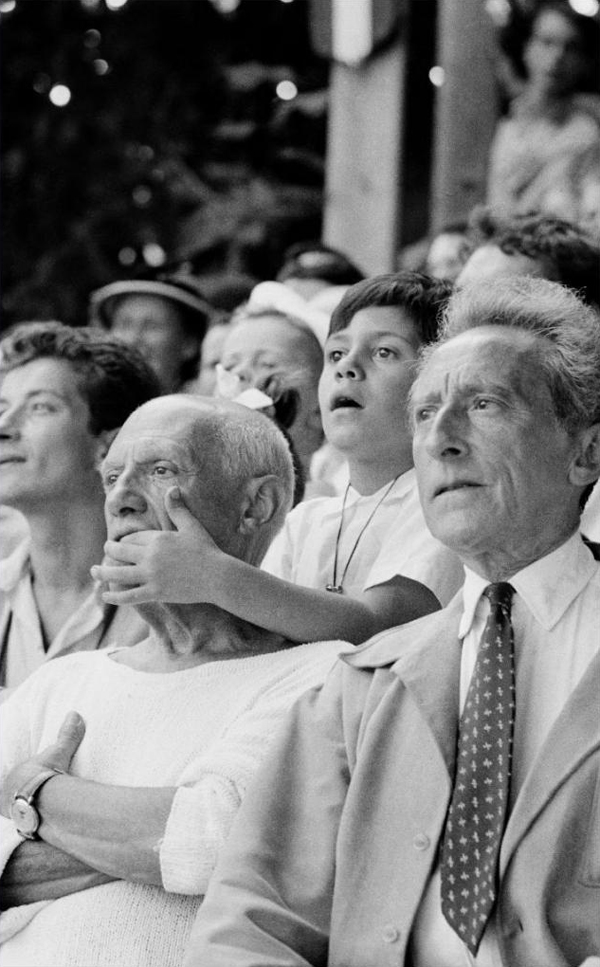Narrative momentum. The very element lacking in our daily life. Are sort seems to be what Walter Benjamin called “messy antics” ; making new out of the scrap heap of discard, an early perception of appropriation and genre bending that would characterize modernism. The “shock of the new” , the appearance of the urban species as remarked by Baudelaire: the flaneur, the prostitute, and the ragpicker as being in their natural habitat in the urban milieu. The stories people began telling themselves, and still do, even as we try to fill them to coherence, significance, dressed up with some form of dramatic logic, usually contrived, typically ends up being flawed and compromised, contradictory, and chocked full of elements of disavowal allowing us to bathe in the much and make moral hay simultaneously.

—Jean Cocteau and Picasso at Bullfight
1955, photo by Brian Brake—Read More:http://art-portrait.livejournal.com/4792.html
“In my case a picture is a sum of destructions,” Picasso famously said. “In the end, though, nothing is lost.” Destructions. The nihilistic side seems intrinsic to modernism; and in this sense lends itself to some of the more pitiful aspects of the counter-enlightenment. Think Tristan Tzara playing chess outside the Cabaret Voltaire with Lenin. Or Heidegger as mouthpiece for the Third Reich and the whole notion of a scorched earth mentality where modernist art was the split off side people like the Nazis refused to see so they simply labeled it “degenerate.”
Even an evil nut-job like Himmler was nonetheless a cultured man, sort of, and could see in this new art, elements of liberation were contained by other elements that enslaved, Picasso’s African masks and Swing music contained melodramas of vulgarity and a path of ugliness within the disrupted momentum. Art defeating and self defeating nihilism over the point of no return to traditional classical beauty. After the initial energetic, psychic surges which could not be sustained there had to be a leveling off down to the dregs, a few poses and gestural shards…
( see link at end) …Picasso’s “role model,” as Minotauromachy, 1935, makes clear. They can never again become completely animal, as Zeus did when he became the bull who raped Europa — and as Picasso did when he identified with the bull in Guernica, 1937, however unconsciously. It was an identification with the aggressor, the rapist of Spain, the enemy of European civilization, suggesting that Picasso realized that his art was uncivilized, primitive, animal, barbaric or, as he said, destructive. He was as destructive as a wild bull, however much his art seemed to “manage” — not tame — his destructiveness, or at least give it socially tolerable, “displaced” form. His ugly Cubist and Surrealist figures are a far cry from the embodiments of civilized, humane — humanizing — ideals in classically beautiful figures, which the figures in his so-called Ingres style drawings and paintings are a pale, diluted emulation of….

—In 1959, when Amram and Kerouac and those friends were putting together what they thought of as a “little home movie” called “Pull My Daisy.” A photographer captured Amram, Kerouac, Jerry Rivers, Allen Ginsburg and Gregory Corso in a photo that has become famous.
You’d think the photo showed the Algonquin Round Table of the beats, the “Trilateral Commission of the Beat Generation,” Amram said,—Read More:http://www.nj.com/gloucester-county/towns/index.ssf/2011/08/chance_meeting_led_to_long_fri.html
…Picasso’s whole art — certainly in its Cubist, Surrealist and Cubo-Surrealist phases — can be said to be premised on the contemptuous dismissal, not to say nihilistic rejection, of classical beauty, indeed, deliberate violation of its idealism in the name of a perverse regression to primitive pre-art….Read More:http://www.artnet.com/magazineus/features/kuspit/willem-de-kooning-at-moma-10-6-11.asp
Its the fruition of the “disenchanted world.” That radical transformation of society after the Protestant Reformation meant a divinely appointed cosmos, alive with spiritual presence would implode into a bustling pool of sellers and consumers, bourgeois values, enterprise and rampant individualism in the name of freedom; as a Picasso clearly saw, the figurative view of the world, to him, was both pointless and dishonest to represent in traditional ways since the time honored old human narrative had been fatally disrupted. It was a judgement that this was the only valid response to a world that could not be repaired.

—…and the 1926 Why not Sneeze, Rose Sélavy? We are not here concerned with their elaborate wit — the noise-maker in Noise muffled in twine and metallically bolted out of earshot; the Sneeze birdcage filled with heavy marble “sugarcubes”, and garnished with a cuttle bone for a bird to sharpen its beak on, and a thermometer, creating a tiny captive circus of weight and the science of flight. No, the important matter in these pieces is the purposive arrangement made absolutely pure by its application to readymade elements lacking all positive or negative aesthetic qualities, emotional overtones or apparent logic. These are probably the first true assemblages, and one must look to Fluxus for their only impressive successors. —Read More:http://www.invisiblebooks.com/Duchamp.htm
( see link at end)…”The beauties of the Parthenon, Venuses, nymphs, Narcissuses, are so many lies,” Picasso aggressively declared. “Art is not the application of a canon of beauty” — as though beauty was merely “academic,” he adds — “but what the instinct and the brain can conceive beyond any canon.” Uncontained by any canonical order, the artist is free — if it is freedom rather than compulsion — to “express what is in [him],” more pointedly “unload” his troublesome emotions: the “anxiety” of Cézanne, the “torments” of Van Gogh. “Even if the apple Jacques Émile Blanche painted had been ten times as beautiful” as the apple Cézanne painted, it would not convey “the actual drama of the man.” This attack on beauty — now supposedly in the name of the sublime, which he finds in primitive pre-art rather than in the human drama — reaches a climax of sorts in Barnett Newman’s assertion that “the impulse of modern art was this desire to destroy beauty,” more particularly, to “discard Renaissance notions of beauty” grounded in “the ideals of Greek beauty.”…Read More:






 COMMENTS
COMMENTS